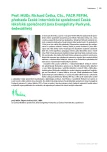What has the GLAGOV clinical study shown?
Authors:
Ján Murín
Authors‘ workplace:
I. interná klinika LF UK a UNB, Nemocnica Staré mesto, Bratislava, Slovenská republika
Published in:
Vnitř Lék 2017; 63(5): 329-332
Category:
Reviews
Overview
If we want to favorably influence the cardiovascular atherosclerotic disease, it is necessary to significantly lower LDL-C blood levels. PCSK9 inhibitors can significantly reduce LDL-cholesterol levels, being administered together with statins. However we focus on establishing whether this plays a role in influencing coronary atherosclerosis. The GLAGOV study is a multicentric, double-blinded and placebo-controlled study which during a 76-week period followed an impact of the treatment with evolocumab (PCSK9i) together with statin on the status of coronary atherosclerosis in patients with ischemic heart disease, and in comparison with the statin treatment. 968 patients at an average age of 60 have reached a significant decline in the levels of serum LDL-cholesterol (from 2.39 to 0.95 mmol/l) in the branch of the combined therapy, which led to a considerable reduction of percent atheroma volume in the coronary artery by 0.95% (in the branch of the statin-only therapy, the percent atheroma volume increased by 0.05%). The therapy was safe. As shown by the results, evolocumab can through additional reduction of blood levels of LDL-C favorably influence (reduce) coronary atherosclerosis.
Key words:
evolocumab – regression of coronary atherosclerosis – LDL-C blood levels
Sources
1. LaRosa JC, Grundy SM, Waters DD et al. [Treating to New Targets (TNT) investigators]. Intensive lipid lowering with atorvastatin in patients with stable coronary disease. N Engl J Med 2005; 352(14): 1425–1435.
2. Baigent C, Blackwell L, Emberson J et al. [Cholesterol Treatment Trialists’ (CTT) Collaboration]. Efficacy and safety of more intensive lowering of LDL cholesterol: a meta-analysis of data from 170 000 participants in 26 randomised trials. Lancet 2010; 376(9753): 1670–1681. Dostupné z DOI: <http://dx.doi.org/10.1016/S0140–6736(10)61350–5>.
3. Probstfield JL, Davis BR et [ALLHAT Officers and Coordinators for the ALLHAT Collaborative Research Group]. Major outcomes in moderately hypercholesterolemic, hypertensive patients randomized to pravastatin vs usual care – the ALLHAT-LLT. JAMA 2002; 288(23): 2998–3007.
4. Pasternak RC. The ALLHAT lipid lowering trial – less is less. JAMA 2002; 288(23): 3042–3044.
5. Fellstroem BC, Jardine AG, Schmieder RE et al. Rosuvastatin and cardiovascular events in patients undergoing hemodialysis. N Engl. J Med 2009; 360(14): 1395–1407. Dostupné z DOI: <http://dx.doi.org/10.1056/NEJMoa0810177>. Erratum in N Engl J Med 2010; 362(15):1450.
6. Wanner C, Krane V, Maerz W et al. Atorvastatin in patients with type 2 diabetes mellitus undergoing hemodialysis. N Engl J Med 2005; 353(3): 238–248. Erratum in N Engl J Med 2005; 353(15): 1640.
7. Nicholls SJ, Ballantyne CM, Barter PJ et al. Statins, high-density lipoporotein cholesterol, and regression of coronary atherosclerosis. JAMA 2007; 297(5): 499–508.
8. Nissen SE, Nicholis SJ, Sipahi I et al. [ASTEROID investigators]. Effect of very high-intensity statin therapy on regression of coronary atherosclerosis: the ASTEROID trial. JAMA 2006; 295(13): 1556–1565.
9. Nissen SE, Tuzcu EM, Schoenhagen P et al. [REVERSAL Investigators]. Effect of intensive compared with moderate lipid-lowering therapy on progression of coronary atherosclerosis: a randomized controlled trial. JAMA 2004; 291(9): 1071–1080.
10. Ridker PM, Danielson E, Fonseca FA et al. Rosuvastatin to prevent vascular symptoms in men and women with elevated C reactive protein. N Engl J Med 2008; 359(21): 2195–2207. Dostupné z DOI: <http://dx.doi.org/10.1056/NEJMoa0807646>.
11. Abifadel M, Varret M, Rabes JP et al. Mutations in PCSK9 cause autosomal dominant hypercholesterolemia. Nat Genet 2003; 34(2): 154–156.
12. Maxwell KN, Breslow JL. Adenoviral-mediated expression of PCSK9 in mice results in a low-density lipoprotein receptor knockout phenotype. Proc Natl Acad Sci USA 2004; 101(18): 7100–7105.
13. Robinson JG, Nedergaard BS, Rogers WJ et al. [LAPLACE-2 Investigators]. Effect of evolocumab or ezetimibe added to moderate – or high-intensity statin therapy on LDL-C lowering in patients with hypercholesterolemia: the LAPLACE-2 randomized clinical trial. JAMA 2014; 311(18): 1870–1882.
14. Blom DJ, Hala T, Bolognese M et al. [DESCARTES investigators]. A 52-week placebo-controlled trial of evolocumab in hyperlipidemia. N Engl J Med 2014; 370(19): 1809–1819. Dostupné z DOI: <http://dx.doi.org/10.1056/NEJMoa1316222>.
15. Puri R, Nissen SE, Somaratne R et al. Impact of PCSK9 inhibition on coronary atheroma progression: rationale and design of Global Assessment of Plaque Regression with a PCSK9 Antibody as Measured by Intravascular Ultrasound (GLAGOV). Am Heart J 2016; 176: 83–92. Dostupné z DOI: <http://dx.doi.org/10.1016/j.ahj.2016.01.019>.
16. Nicholls SJ, Puri R, Anderson T et al. Effect of Evolocumab on Progression of Coronary Disease in Statin-Treated Patients: The GLAGOV Randomized Clinical Trial. JAMA 2016; 316(22): 2373–2384. Dostupné z DOI: <http://dx.doi.org/10.1001/jama.2016.16951>.
17. Jones PH, Nair R, Thakker KM. Prevalence of dyslipidemia and lipid goal attainment in statin-treated subjects from 3 data sources: a retrospective analysis. J Am Heart Assoc 2012; 1(6): e001800. Dostupné z DOI: <http://dx.doi.org/10.1161/JAHA.112.001800>.
18. Libby P. The forgotten majority: unfinished business in cardiovascular risk reduction. J Am coll Cardiol 2005; 46(7): 1225–1228.
19. Domanski MJ, Fuster V, Mitoma FD et al. Next steps in primary prevention of coronary heart disease. J Am Coll Cardiol 2015; 66(16): 1828–1836. Dostupné z DOI: <http://dx.doi.org/10.1016/j.jacc.2015.08.857>.
Labels
Diabetology Endocrinology Internal medicineArticle was published in
Internal Medicine

2017 Issue 5
Most read in this issue
- Acute lymphoblastic leukemia of adults – a case of prolonged hip pain diagnostics with a surprising conclusion: case report
- Osteoprotective therapy with bisphosphonates or denosumab in patients with multiple myeloma: benefit and risks
- Is it intestinal tuberculosis again? Case report
- Thoughts about valvular abnormalities yesterday and today
